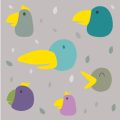Recognizing an Avian Emergency
Birds are masters at hiding their illnesses, making it crucial for owners to spot the subtle signs of distress before things become critical. Knowing when your feathered companion is in trouble starts with careful observation of their daily habits and behaviors. Look out for sudden changes—such as a drop in activity level, unusual aggression or fearfulness, sitting fluffed up on the cage floor, or persistent vocalization that isn’t normal for your bird. These behavioral red flags often signal that something is wrong long before more obvious symptoms appear.
Behavioral Red Flags
Pay attention to your bird’s posture and movement. If your bird is lethargic, seems unsteady on its perch, refuses to eat or drink, or isolates itself from family members, these are all potential signs of serious health issues. Birds experiencing distress might also pluck their feathers excessively, breathe with an open beak, or show tail bobbing—a sign of labored breathing.
Subtle Symptoms to Watch For
Beyond the more dramatic behavioral changes, subtle symptoms can indicate an emergency situation. These include changes in droppings (color, consistency, frequency), swollen eyes or eyelids, discharge from the nostrils or mouth, and discoloration of the skin or beak. Even minor wounds can escalate quickly in birds due to their rapid metabolism and delicate physiology.
Why Quick Recognition Matters
Unlike dogs or cats, birds can deteriorate rapidly once they become visibly ill. Immediate recognition and response are vital to give your pet the best chance at recovery. By staying attuned to both obvious and subtle warning signs, you’ll be prepared to act fast and potentially save your bird’s life when emergencies arise.
2. Building a Bird-Specific First Aid Kit
When it comes to bird first aid, grabbing supplies from your own medicine cabinet simply won’t cut it. Birds have unique needs and sensitivities, so every U.S. bird owner should keep a dedicated kit tailored for feathered friends. Here’s what you’ll want on hand—not just for peace of mind, but for real emergencies.
Essential Bird-Safe Supplies
| Item | Why It Matters | U.S. Availability Tip |
|---|---|---|
| Styptic Powder or Cornstarch | Stops minor bleeding from broken feathers or nails safely—never use products with benzocaine or lidocaine. | Pet stores and avian vets stock bird-safe styptic powder; avoid “Kwik Stop” meant for dogs/cats. |
| Gauze Pads & Vet Wrap | For gentle pressure and secure bandaging—regular adhesive tape can harm delicate skin and feathers. | Look for “vet wrap” in farm supply stores; always keep sterile gauze in original packaging. |
| Blunt-Tip Scissors & Tweezers | Safe handling of bandages and debris—sharp tips risk injury to birds who fidget or panic. | Baby nail scissors work well; label them “bird only.” |
| Saline Solution (Unmedicated) | Cleans eyes or wounds without stinging or leaving residue unsafe for birds. | Avoid contact lens solutions with additives—buy plain saline at any pharmacy. |
| Small Towels or Washcloths | For gentle restraint—birds stress easily, so soft, clean towels help contain and calm them. | Laundry with fragrance-free detergent is best; keep a few in your kit. |
| Syringes (No Needles) | To offer fluids if instructed by a vet, or for precise wound irrigation. | Pediatric oral syringes are easy to find at U.S. pharmacies. |
| Heating Pad (Low Setting) or Hot Water Bottle | Birds lose heat quickly during shock; gentle warmth can be life-saving while seeking veterinary care. | Avoid electric heating pads that lack a “low” setting; microwavable rice socks also work in a pinch. |
Think Beyond Human Medicine Cabinets
Avoid common human ointments, creams, and painkillers—they can be toxic to birds. Instead, focus on single-use, unscented, and non-medicated options whenever possible. If your bird has special medical needs or you live in an area prone to natural disasters (like hurricanes or wildfires), ask your avian vet about additional must-haves specific to your region and species. Keeping these bird-specific supplies ready means you’ll never have to improvise in a crisis—and your feathered friend will thank you.
![]()
3. Safe Handling During a Crisis
When your bird is injured or suddenly ill, every second counts. But acting quickly doesn’t mean rushing in without care. Birds are delicate creatures, easily stressed by unfamiliar handling—especially during emergencies. Mastering gentle, stress-free handling techniques is essential to protect both your feathered friend and yourself.
Understanding Bird Behavior Under Stress
First, recognize the signs of fear or pain: rapid breathing, fluffed feathers, biting, or vocal distress. Even the tamest pet bird can panic when frightened or hurt. Always approach slowly and speak in a calm, reassuring voice. Avoid sudden movements that could escalate their anxiety.
Essentials for Safe Bird Handling
- Use a Towel: Keep a clean, soft towel nearby. Drape it gently over your bird to limit wing flapping and protect yourself from bites or scratches. Make sure the head is exposed for easy breathing.
- Support the Body: With your hands wrapped in the towel, support the bird’s body firmly but gently. Never squeeze—just enough pressure to prevent escape without causing harm.
- Avoid Restricting the Chest: Birds need their chest free to breathe. Do not press on the chest area while restraining them.
Protecting Yourself and Your Pet
In stressful moments, even loving birds may bite or scratch out of fear. Wear gloves if needed for larger parrots, but remember that dexterity is important—prioritize control over force. If you feel unsure or the bird resists strongly, pause and reassess; further injury can occur with improper handling.
When to Seek Immediate Help
If your bird is bleeding heavily, has trouble breathing, or loses consciousness during handling, stop and call an avian veterinarian right away. Safe handling isn’t just about comfort—it’s about survival during those critical first moments before professional help arrives.
4. Quick Response for Common Injuries
When your pet bird faces an emergency, a quick and calm response can make all the difference. Here’s a step-by-step guide tailored for American pet households, addressing some of the most common bird injuries you might encounter.
Bleeding
If you notice blood, stay calm. Gently restrain your bird using a towel to prevent further injury. Apply direct pressure with a sterile gauze pad to the bleeding area for several minutes. Never use cotton balls—they can stick to wounds. For minor bleeding from a toenail or beak, a commercial styptic powder (available at most pet stores in the U.S.) can help stop the bleeding. If bleeding persists after 10 minutes, contact your avian vet immediately.
Broken Feathers
Broken blood feathers are especially concerning due to the risk of significant blood loss. Use tweezers or hemostats to firmly grasp the feather shaft at the base and pull it out in one smooth motion, but only if youre comfortable doing so. If not, stabilize your bird by gently wrapping it in a towel and get to your vet quickly.
| Injury Type | Immediate Action | When to Call the Vet |
|---|---|---|
| Bleeding | Apply direct pressure with gauze; use styptic powder for nails/beak. | If not stopped after 10 minutes or heavy bleeding occurs. |
| Broken Feather | Remove broken blood feather if trained; otherwise stabilize and seek help. | If bleeding is uncontrolled or you cannot remove safely. |
| Minor Cuts/Scrapes | Clean with saline solution and cover lightly if needed. | If wound is deep or shows signs of infection. |
Breathing Trouble
If your bird is having difficulty breathing—open-mouth breathing, tail bobbing, or wheezing—move them to a quiet, warm area away from drafts and other pets. Avoid handling more than necessary. Do not try home remedies or over-the-counter medications. Contact your avian veterinarian immediately as respiratory issues can quickly become life-threatening in birds.
Other Emergencies: Step-by-Step Checklist
- Shock: Keep your bird warm and quiet; minimize stress until you reach professional care.
- Puncture Wounds: Cover with sterile gauze, avoid ointments, and seek veterinary attention promptly.
- Poisons: Identify the source and call an animal poison control hotline—do not induce vomiting unless instructed by a vet.
The Takeaway for American Bird Owners
Your quick response can save your feathered friend’s life. Keep a well-stocked first aid kit specifically for birds and know where your nearest avian vet is located. Respond calmly, follow these steps, and always reach out for professional help when needed.
5. When (and How) to Call the Vet
Knowing when to reach out to an avian veterinarian is a critical skill for every bird owner in the United States. Certain situations—like heavy bleeding, difficulty breathing, sudden collapse, or signs of poisoning—require immediate professional attention. Don’t wait and see; birds can deteriorate rapidly, so time is of the essence.
Recognizing True Emergencies
If your bird is unresponsive, having seizures, or cannot stand, these are red flags that demand urgent care. Other emergencies include injuries from other pets, broken bones, swallowed toxic items, or visible wounds with active bleeding. If you’re unsure whether it’s an emergency, err on the side of caution and call your vet.
What Information to Have Ready
When calling your avian vet or an emergency clinic, be prepared to clearly describe your bird’s species, age, symptoms, how long the problem has been going on, any possible exposure to toxins (like household cleaners or non-stick cookware fumes), recent behavioral changes, and what first aid steps you’ve already taken. This information helps the veterinary team prepare for your arrival and offer advice over the phone.
Advocating for Fast Care
In a busy U.S. veterinary clinic, it’s important to be polite but assertive. Let staff know you have a true avian emergency; specify symptoms like trouble breathing or heavy bleeding. Ask if there is an avian specialist on duty. If not, request guidance on the nearest facility equipped for bird emergencies. Keep your phone charged and nearby while waiting for callbacks.
Ultimately, acting quickly—and knowing how to communicate effectively with veterinary professionals—can mean the difference between life and death for your feathered friend.
6. Preventive Steps and Home Safety
Why Prevention Matters
When it comes to emergency first aid for birds, the best scenario is avoiding emergencies altogether. Being proactive about your bird’s environment and daily habits can drastically reduce risk and help you sidestep many common household hazards.
Bird-Proofing Your Space
Secure Windows and Doors
Birds are curious by nature, and an open window or unlocked screen is a tempting escape route or collision hazard. Install sturdy screens, use decals to prevent window strikes, and always check doors before letting your feathered friend out of its cage.
Remove Toxic Hazards
Many everyday items—like scented candles, Teflon cookware, certain houseplants, and aerosol sprays—can be toxic or deadly to birds. Store cleaning products safely away from flight paths, avoid using nonstick pans, and double-check plants for toxicity before bringing them home.
Eliminate Small Objects and Choking Risks
Tiny toys, jewelry, rubber bands, and other small objects can become dangerous if swallowed or chewed. Regularly inspect play areas and living spaces to remove choking hazards and keep your bird’s toys bird-safe and in good condition.
Habits That Help Keep Birds Safe
Supervised Out-of-Cage Time
Whenever your bird is out exploring, keep a watchful eye on them. Supervised playtime helps prevent accidents, like getting stuck behind furniture or chewing on electrical cords.
Routine Health Checks
A quick daily glance at your bird’s behavior, feathers, droppings, and activity level can alert you to early signs of illness or injury. Early detection often means easier treatment and a better outcome.
Create an Emergency Plan
No matter how careful you are, emergencies can still happen. Keep your avian first aid kit stocked and accessible. Post important contact numbers—including your avian vet—in a visible spot. Make sure everyone in your household knows what to do if there’s ever an urgent situation involving your bird.
The Bottom Line: Safety Starts at Home
The more effort you put into prevention today, the less likely you’ll face a crisis tomorrow. By making simple changes to your space and routine, you build a safer world for your companion bird—long before emergencies ever have a chance to occur.


